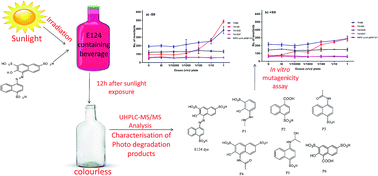Separation, identification and mutagenic assessment of the photodegradation products of Ponceau 4R (E124) in a beverage†
Abstract
Azo dyes and their degradation products frequently show potential carcinogenic and genotoxic effects and can cause potential hazards to consumer health. In the present study, the photo-degradation products of Ponceau 4R (E124) in a beverage were identified by non-target screening via ultra high performance liquid chromatography coupled with high resolution quadrupole-time-of-flight mass spectrometry (UHPLC-Q-TOF-MS/MS). Accurate mass measurements were used to identify the elemental composition and to elucidate the structures of the degradation products. The identified degradation products are formed from side-reactions and/or from the interactions occurring between the E124 dye and the other ingredients of the beverage (citric acid, fructose syrup, sucrose and grape juice). The mutagenic potential of the degradation products was investigated via an in vitro bacterial reverse mutation (Ames) assay using TA 98, TA 100, TA 1535, TA 1537 and WP2 uvrA pKM101, with and without the S9 fraction. The results were positive in strains TA 98 (without S9) and TA 100 (with and without S9) as detected by the Ames assay. Furthermore, the presence of sulfonated aromatic amine and sulfonated aromatic amide groups in the skeleton of the degradation products could be the reason for potential mutagenicity.


 Please wait while we load your content...
Please wait while we load your content...